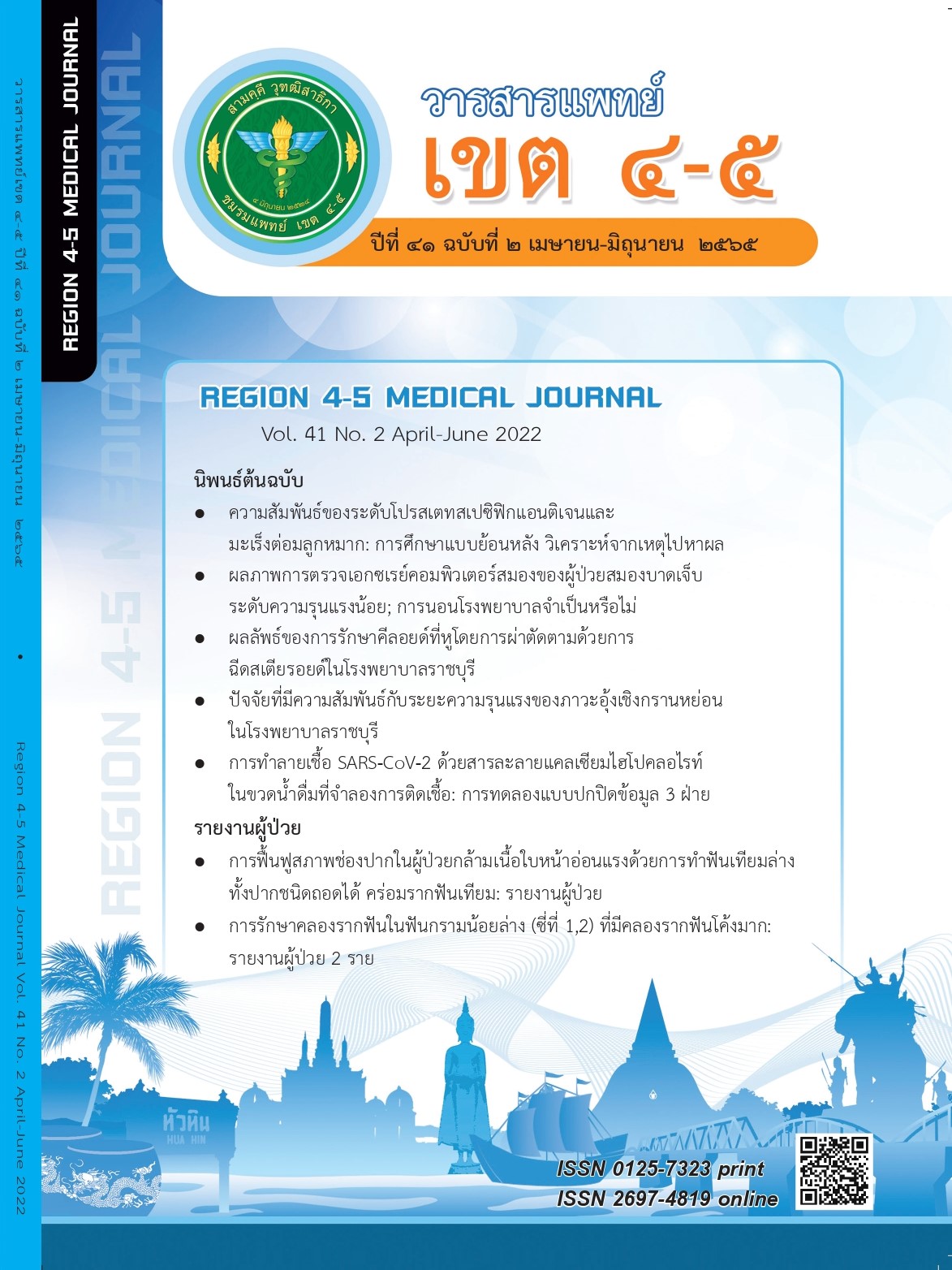Standardization of Intermediate Care in Phetchaburi
คำสำคัญ:
intermediate care system, system developmentบทคัดย่อ
Objective: The purposes of this study were to investigate and develop a intermediate care system of Phetchaburi Province, Banlat network, and to evaluate the outcomes of the system.
Methods: Research and development methodology were used in this research. The samples consisted of three groups of intermediate-care stakeholders, 8 persons per group; 30 intermediate care-receivers with three-targeted diseases, (stroke, traumatic brain injury, and spinal cord injury) and 30 caregivers. Purposive sampling was used. The focus group questions, questionnaires, an activity daily living assessment form and a readiness of independent living assessment form were conducted. Statistics used were frequency, percentage, standard deviation, paired t test, and content analysis.
Results: The problems of the intermediate-care operation situation of Phetchaburi Province, Banlat network were inability to access the service, patients’ denial to stay in hospital, lack of rehabilitation knowledge and skills of caregivers, and effects of COVID-19 pandemic on health service. Based on this situation, the new intermediate care system was developed including 1) principle and objectives 2) intermediate-care operation procedures 3) system operation support and 4) evaluation. The system outcome evaluation showed that the intermediate-care service accessible rate was 100 percent. The activity daily living score (Barthel index: BI) after receiving the intermediate-care service was higher than before with statistical significance (p-value < .001). The complication rate was 0 percent. Every caregiver (100 percent) was passed the examination of readiness of independent living.
Conclusion: This intermediate care system of Phetchaburi Province, Banlat network, which was developed, can be implemented practically and effectively. All patients able to access the service, can depend on themself in daily living more than before, and keep away from the complications. Moreover, the caregivers were ready to do the rehabilitation for the patients at home.
เอกสารอ้างอิง
อรทัย เขียวเจริญ, ศุภสิทธิ์ พรรณารุโณทัย, วัชรา ริ้วไพบูลย์, และคณะ. การพัฒนาการจัดบริการฟื้นฟูสมรรถภาพทางการแพทย์ สำหรับผู้ป่วยระยะกึ่งเฉียบพลันและไม่เฉียบพลันในระบบหลักประกันสุขภาพถ้วนหน้าของประเทศไทย. วารสารวิชาการสาธารณสุข. 2558;24(3):493–509.
กองบริหารการสาธารณสุข สำนักงานปลัดกระทรวงสาธารณสุข. คู่มือการฟื้นฟูสมรรถภาพผู้ป่วยระยะกลาง Guideline for Intermediate care สำหรับบุคลากรทางการแพทย์ตามแผนพัฒนาระบบบริการสุขภาพ (Service Plan). สมุทรสาคร: บอร์นทูบีพับลิชชิ่ง; 2562: 8–14.
Pearson M, Hunt H, Cooper C, et al. Providing effective and preferred care closer to home: a realist review of intermediate care. Health Soc Care Community 2015:23(6):577–93.
เบญจพร สุธรรมชัย,นภัส แก้ววิเชียร. สถานการณ์การดำเนินงาน Intermediate care ของผู้สูงอายุในประเทศไทย. กรุงเทพฯ: บียอนด์พับลิสซิ่ง; 2561: 19–39.
กระทรวงสาธารณสุข. นโยบาย Intermediate care [อินเทอร์เน็ต]. 2560 [เข้าถึงเมื่อ1 ธันวาคม 2561]; เข้าถึงได้จาก: https://r8way. moph.go.th/r8wayadmin/page/uploads_fil
ธัญพร ชื่นกลิ่น, นงณภัทร รุ่งเนย, นภัส แก้ววิเชียร, และคณะ. ประเมินนโยบายการดูแลสุขภาพระยะกลางของกระทรวงสาธารณสุข: การวิเคราะห์เชิงปริมาณ. วารสารวิจัยระบบสาธารณสุข. 2564;15(2):183–99.
สำนักงานเขตสุขภาพที่ 5. เอกสารประกอบการประชุม: สรุปผลการพัฒนา Service plan: Intermediate care ปี 2563; 2564. ราชบุรี: สำนักงานเขตสุขภาพที่ 5; 2564.
สำนักงานสาธารณสุขจังหวัดเพชรบุรี. รายงานสรุปผลการดำเนินงาน intermediate care. เพชรบุรี: สำนักงานสาธารณสุขจังหวัดเพชรบุรี; 2564.
สำนักงานสาธารณสุขจังหวัดเพชรบุรี. เอกสารประกอบการตรวจราชการและนิเทศงานกระทรวงสาธารณสุข กรณีปกติ รอบที่ 2 ประจำปี 2564 จังหวัดเพชรบุรี. วันที่ 3 – 4 สิงหาคม 2564. เพชรบุรี: สำนักงานสาธารณสุขจังหวัดเพชรบุรี; 2564: 141–4.
World Health Organization. Monitoring the Building Blocks of Health Systems: A Handbook of Indicators and Their Measurement Strategies. Geneva Switzerland: WHO Document Production Services; 2010: 1–85.
อวยพร จงสกุล, ศิริพร สีสันต์, กัญญา เลี่ยนเครือ, และคณะ. รูปแบบการจัดการการดูแลผู้ป่วยหลอดเลือดสมองเพื่อฟื้นฟูความสามารถในการปฏิบัติกิจวัตรประจำวัน โรงพยาบาลพหลพลพยุหเสนา: OIMCCE Model. วารสารแพทย์เขต 4-5 2563;39(3):454–71.
นงณภัทร รุ่งเนย, ธัญพร ชื่นกลิ่น, นภัส แก้ววิเชียร, และคณะ. ปัจจัยที่มีอิทธิพลต่อความยั่งยืนของนโยบายการดูแลสุขภาพระยะกลางในโรงพยาบาลสังกัดกระทรวงสาธารณสุข. วารสารวิชาการสาธารณสุข 2565,31(1):112–23.
Perez LM, Inzitari M, Quinn TJ, et al. Rehabilitation Profiles of Older Adult Stroke Survivors Admitted to Intermediate Care Units: A Multi-Centre Study. PloS ONE 2016;11(11):e0166304.
Kaambwa B, Bryan S, Barton P, et al. Cost and health outcomes of intermediate care: results from five UK case study sites. Health and Social Care in the Community. 2008;16(6):573–81.
Mabunda SA, London I, Piennaar D. An evaluation of the role of an intermediate care facility in the continuum of care in Western Cape, South Africa. Int J Health Policy Manag. 2018;7(2):167–79.
ดาวน์โหลด
เผยแพร่แล้ว
รูปแบบการอ้างอิง
ฉบับ
ประเภทบทความ
สัญญาอนุญาต

อนุญาตภายใต้เงื่อนไข Creative Commons Attribution-NonCommercial-NoDerivatives 4.0 International License.
ลิขสิทธิ์บทความเป็นของผู้เขียนบทความ แต่หากผลงานของท่านได้รับการพิจารณาตีพิมพ์ลงวารสารแพทย์เขต 4-5 จะคงไว้ซึ่งสิทธิ์ในการตีพิมพ์ครั้งแรกด้วยเหตุที่บทความจะปรากฎในวารสารที่เข้าถึงได้ จึงอนุญาตให้นำบทความในวารสารไปใช้ประโยชน์ได้ในเชิงวิชาการโดยจำเป็นต้องมีการอ้างอิงถึงชื่อวารสารอย่างถูกต้อง แต่ไม่อนุญาตให้นำไปใช้ในเชิงพาณิชย์




